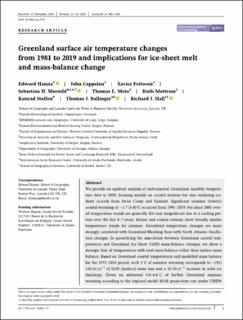Greenland surface air temperature changes from 1981 to 2019 and implications for ice-sheet melt and mass-balance change
Hanna, Edward; Cappelen, John; Fettweis, Xavier; Mernild, Jacob Sebastian Haugaard; Mote, Thomas L.; Mottram, Ruth; Steffen, Konrad; Ballinger, Thomas J.; Hall, Richard J.
Journal article, Peer reviewed
Published version

Åpne
Permanent lenke
https://hdl.handle.net/11250/2738020Utgivelsesdato
2020Metadata
Vis full innførselSamlinger
- Geophysical Institute [1198]
- Registrations from Cristin [9791]
Sammendrag
We provide an updated analysis of instrumental Greenland monthly temperature data to 2019, focusing mainly on coastal stations but also analysing ice‐sheet records from Swiss Camp and Summit. Significant summer (winter) coastal warming of ~1.7 (4.4)°C occurred from 1991–2019, but since 2001 overall temperature trends are generally flat and insignificant due to a cooling pattern over the last 6–7 years. Inland and coastal stations show broadly similar temperature trends for summer. Greenland temperature changes are more strongly correlated with Greenland Blocking than with North Atlantic Oscillation changes. In quantifying the association between Greenland coastal temperatures and Greenland Ice Sheet (GrIS) mass‐balance changes, we show a stronger link of temperatures with total mass balance rather than surface mass balance. Based on Greenland coastal temperatures and modelled mass balance for the 1972–2018 period, each 1°C of summer warming corresponds to ~(91) 116 Gt·yr−1 of GrIS (surface) mass loss and a 26 Gt·yr−1 increase in solid ice discharge. Given an estimated 4.0–6.6°C of further Greenland summer warming according to the regional model MAR projections run under CMIP6 future climate projections (SSP5‐8.5 scenario), and assuming that ice‐dynamical losses and ice sheet topography stay similar to the recent past, linear extrapolation gives a corresponding GrIS global sea‐level rise (SLR) contribution of ~10.0–12.6 cm by 2100, compared with the 8–27 cm (mean 15 cm) “likely” model projection range reported by IPCC in 2019 (SPM.B1.2). However, our estimate represents a lower limit for future GrIS change since fixed dynamical mass losses and amplified melt arising from both melt‐albedo and melt‐elevation positive feedbacks are not taken into account here.
